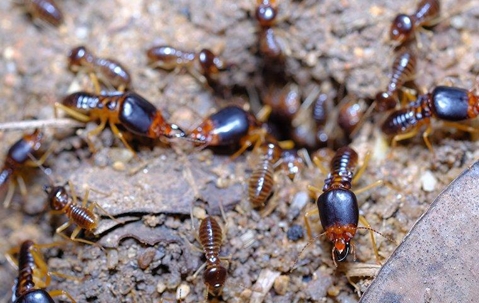Termites. It's a word any homeowner dreads to hear, and rightly so. According to the National Pest Management Association (NPMA), termites cause over $5 billion in property damage annually in the United States alone, a cost not usually covered by homeowners' insurance. Subterranean termites (one type of termite) eat 24/7, making them the most destructive species of termite found in the U.S.
These wood-loving insects easily eat a variety of things: wood, paper, fiberboard. They’ll make meals of your walls, floors, ceiling beams, cornices, foundations, eaves, roof rafters, and crawlspaces. Your Frisco home can become their termite palace, building colonies inside, under, and around the home. You may even find them in furniture.
However, termites also don’t have an affinity for just old wood. Wood is wood to them, whether it’s new construction or an older home. If there’s wood involved, it’s fair game.
How Do You Know if You Have a Termite Infestation?
There are a number of ways you can tell your Frisco home has a termite infestation. Look for these signs:
- Damaged floors that have blisters and/or sagging.
- Ceiling beams and cornices that have cracks.
- Foundation damage even if you have concrete. Termites can get into concrete cracks and floor joists made of wood.
- Unexplained wall cracks.
- Doors or windows that are hard to open.
- Wood that sounds hollow when knocked or tapped on.
- Frass—a term for termite droppings and wood particles— on your Frisco property.
- Branches of trees that may have fallen off.
- Roof tiles that are broken, exposing them to moisture … and termites.
- Mud tubes present—small pieces of wood and soil tunnels that protect termites while traveling between their nest and food sources.
What Does a Termite Look Like?
Termites range in size from 1/8-inch to 1-inch long. They vary in colors ranging from shades of white to brown and black. They have three distinguishable body segments and straight waists, unlike flying ants that have pinched-in waists. Termite swarmers have two sets of wings of equal length and straight antennae.
What Are the Different Termites?
Subterranean termites
Subterranean termites are the most common termites in Northern Texas. Their colonies live underground and can contain as many as 2 million insects. These are the termites that build mud tubes in order to reach food and escape predators. They also thrive in moist areas above ground as well as in sand and mud. Highly destructive in nature, they have strong, saw-tooth-like jaws that are capable of collapsing a building over time.
Subterranean termites have a caste system. It’s the workers that are found in infested wood. Workers are both male and female and are sterile. They’re milky white in color and have no eyes or wings.
Drywood termites
Drywood termites can survive in decayed wood with little moisture content. It’s these termites that can destroy your furniture. A male and female will pair and choose a wood where they’ll nest.
Drywood termites come in different sizes, depending on where they are in their established caste system. Sizes range from ¼- to 3/8-inches.
Termite swarmers
Swarmers are the termites you might see in early spring. These termites will turn into queens and kings of new colonies. They leave their nests and swarm together. Once they land, they will shed their wings, mate, and begin new colonies.
What to Do if Termites Have Made Their Way Into Your Frisco Home?
The best way to beat a termite infestation in your Frisco home is to call in the professionals. To learn more, reach out and contact Adams Exterminating Company for free termite inspection. We can get your Frisco home termite-free, and keep it that way.

